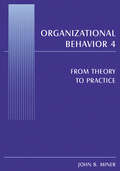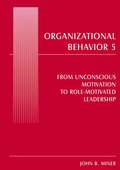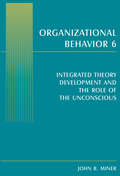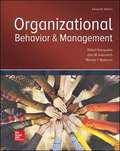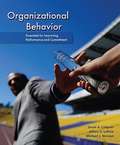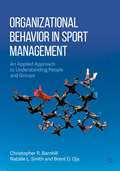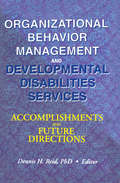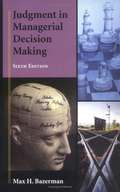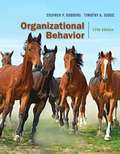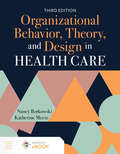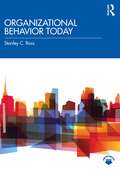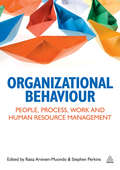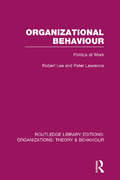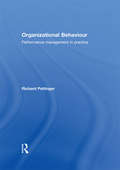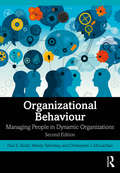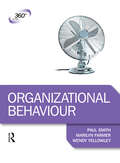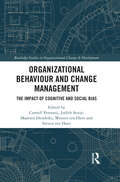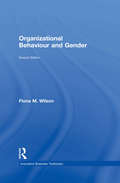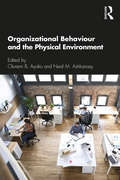- Table View
- List View
Organizational Behavior 4: From Theory to Practice
by John B. MinerThis unique work bridges the gap between theory and practice in organizational behavior. It provides a practical guide to real-life applications of the 35 most significant theories in the field. The author describes each theory, and then analyzes its usefulness and importance to the successful practice of management. His analysis covers key managerial topics such as goal setting, training and development, assessment, job enrichment, influence processes, decision-making, group processes, organizational development, organizational structuring, and effective organizational operation.
Organizational Behavior 5: From Unconscious Motivation to Role-motivated Leadership
by John B. MinerThis volume makes available in one place the large body of research that has been developed over the years on role motivation theory. Author Jack Miner has always been concerned with unconscious factors in human experience, and this work is designed to give proper emphasis to their role in organizational behavior. Part I reviews the current status of projective techniques and the recent work that has been done on unconscious motivation. Part II covers Miner's significant research in the field, from his early work at the Atlantic Refining Company to his career-long leadership studies of Princeton University graduates. The chapters in Part III involve psychometric data analysis, meta-analysis, and factor analysis.
Organizational Behavior 6: Integrated Theory Development and the Role of the Unconscious
by John B. MinerThis is the first comprehensive overview of the development of the field of Organizational Behavior. It belongs on the shelf of every scholar and student in the discipline. Part I covers the foundations of the scientific method, theory development, and the accrual of scientific knowledge in the field. Part II introduces the ideas of pioneers whose work pre-dates the emergence of Organizational Behavior. Part III considers the actual emergence of OB as we know it today, with an analysis of the environmental forces that impinged upon it (such as the recruiting of social scientists into business schools). Part IV presents an assessment of the current state of the art in OB research, with an original assessment of the importance, validity, and practical usefulness of 73 core theories in OB. Finally, Part V sets forth a vision for the future identity and growth of Organizational Behavior research, theory, and practice.
Organizational Behavior and Management (Eleventh Edition)
by Robert Konopaske John M. Ivancevich Michael T. MattesonOrganizational Behavior and Management, students involved participants in learning about behavior and management within work settings. This edition combines text, self-learning exercises, group participation exercises, and cases. These elements are directed at students interested in attempting to predict the behavior of people working in organizations.
Organizational Behavior Essentials for Improving Performance and Commitment
by Jeffery A. Lepine Michael J. Wesson Jason A. ColquittThe book represents the most up-to-date perspective on Organizational Behavior (OB). The author team has written a text that highlights the importance of course topics while organizing them around an integrative model of OB. The text is also contemporary, omitting outdated and impractical models. The text is written in an approachable, conversational tone, with features that students actually want to read.
Organizational Behavior in Sport Management: An Applied Approach to Understanding People and Groups
by Christopher R. Barnhill Natalie L. Smith Brent D. OjaThis textbook presents a comprehensive analysis of organizational behavior in sport organizations from a practitioner's perspective. It covers issues related to managing employees and work teams as well as organizational structure and culture in sport. The book has four sections: Organizational Behavior in the Sports Industry, Getting to Know Employees and Volunteers of Sport Organizations, Work Groups and Teams, and Understanding the Organization. Each chapter begins with a practitioner interview describing a challenge that was overcome by their organization. That example is used to highlight applicable theories and interventions used in the industry. Additional examples or theories are discussed to provide students a broad picture of managerial issues in the sports industry and provide alternative approaches to intervention illustrated in the practitioner interview. The case studies offer the opportunity to practice and apply the ideas to real-world scenarios in the sports industry. Students using this book will gain an understanding of how managers and leaders apply theory to communicate with and engage employees to foster desired organizational cultures while being challenged to address common issues using cases and hypothetical situations.
Organizational Behavior Management and Developmental Disabilities Services: Accomplishments and Future Directions
by Dennis H ReidOrganizational Behavior Management and Developmental Disabilities Services: Accomplishments and Future Directions examines the advances of Organizational Behavior Management (OBM) in human service agencies for individuals with developmental disabilities. Management researchers, working managers, and supervisors will learn strategies for effectively
Organizational Behavior Reading: Negotiation
by Max Bazerman Francesca Gino Katherine ShonkCore Curriculum in Organizational Behavior is a series of readings that cover fundamental course material in Organizational Behavior. Readings include videos and interactive illustrations to help students master complex concepts. Managerial, executive, and entrepreneurial success requires the ability to negotiate. The essential reading and recommended module plan will help students to become more effective negotiators by: 1) mastering a negotiation framework that will help them analyze, prepare for, and execute negotiations more systematically—and hence, more effectively—in a wide variety of contexts; 2) building a negotiation toolkit that consists of practical strategies for creating and capturing value in negotiation; and 3) learning how to create a negotiation environment that helps diagnose individual needs, and allows negotiators to identify techniques for mitigating weaknesses and leveraging their strengths. The supplemental reading addresses two additional topics: cross-cultural negotiations and gender issues in negotiation. This reading includes two videos: "Asking Questions to Understand Interests" and "Post-settlement Settlements."
Organizational Behavior Reading: Developing Your Managerial Career
by Linda A. HillThis Reading examines what it takes to build a successful managerial career. The Essential Reading section contends that a managerial role, by its nature, imposes learning needs that cannot be fully taught in the classroom but must be mastered throughout one's career. It then presents the Developmental Strategies Framework, which focuses on three recurring career challenges: (1) choosing the right position; (2) developing managerial skills by learning from stretch assignments and through periodic reflection; and (3) getting help by building a developmental network. The Reading includes two Supplemental Reading sections: one discusses an approach to honing ethical judgment; the other presents a way to think about integrating work and life goals. The Reading features five videos: "A Great Job Fit," which deals with how to choose new positions; "Seek Challenges," which advocates finding assignments that expand one's knowledge and skill set; "Forging a New Global Comfort Zone," covering the advantages of taking on international opportunities; "Seek Mentors Who Expand Your Comfort Zone," offering advice on how to use mentors; and "Ethical Ambiguity," which provides guidance on the ethical dimensions of managerial decision making. The Reading also includes an Interactive Illustration, "Work Values and Job Selection," in which readers rate five job opportunities, separately rate the importance of nine work values to them, and then analyze whether their job ratings are consistent with their work values.
Organizational Behavior Reading: Leading Organizational Change
by Ryan RaffaelliThis Reading combines conceptual frameworks and research-based knowledge to provide practical guidance about how to lead organization change. The Essential Reading outlines key choices leaders must make when managing a change and the common traps that can cause a change effort to fail. It is organized into four sections, each building on the last to provide a roadmap for change that is effectively tailored to the organization and the situation: 1) Diagnosis: Why is change needed?; 2) Design: What sort of change is called for?; 3) Delivery: How can change best be implemented? Who will most likely be affected? What skills and support do leaders need as they manage the process?; and 4) Evaluation: How can the impact of the change be assessed and measured? The Essential Reading closes with a brief discussion of how new practices such as crowdsourcing, open innovation, and social media campaigns are speeding up change in many industries and altering change processes.
Organizational Behavior Reading: Decision Making
by Katherine Shonk Max H. Bazerman Francesca GinoThis Reading argues that decision making is systematically flawed and introduces methods to improve decision-making effectiveness. The Essential Reading section covers the rational decision-making model and three important ideas that challenge it: Herbert Simon's concept of bounded rationality; Amos Tversky and Daniel Kahneman's work on heuristics and biases; and Keith Stanovich and Richard West's conceptualization of System 1 and System 2 thinking. The Reading then discusses seven common biases or heuristics, along with ways to mitigate them, and lists additional common biases to show the broad range of issues that can influence decision making. The authors also describe biases and additional decision-making challenges that are particular to groups. Finally, the Essential Reading draws on Richard Thaler and Cass Sunstein's concept of choice architecture to present a new framework for better decision making. The Reading includes two Supplemental Reading sections that deal with how motivation and emotion affect decisions, and how flawed decision-making processes can compromise ethics. The Reading also features two videos and one Interactive Illustration.
Organizational Behavior (Seventeenth Edition)
by Stephen P. Robbins Timothy A. JudgeFor undergraduate and graduate courses in Organizational Behavior. Help Students Better Understand Their Behavioral and Interpersonal Skills Long considered the standard for all organizational behavior textbooks, Organizational Behavior provides the research you want, in the language you can understand. This text continues its tradition of making current, relevant research come alive for readers. The Seventeenth Edition has been thoroughly updated to reflect the most recent research and business events within the field of organizational behavior worldwide, while maintaining its hallmark features-clear writing style, cutting-edge content, and intuitive pedagogy. There's a reason why Robbins's textbooks have educated millions of individuals and have been translated into twenty languages-and it's because of a commitment that provides the kind of engaging, cutting-edge material that helps readers understand and connect with organizational behavior. Also Available with MyManagementLabTM MyManagementLab is an online homework, tutorial, and assessment program designed to work with this text to engage students and improve results. Within its structured environment, students practice what they learn, test their understanding, and pursue a personalized study plan that helps them better absorb course material and understand difficult concepts. NOTE: You are purchasing a standalone product; MyManagementLab does not come packaged with this content. If you would like to purchase both the physical text and MyManagementLab search for: 0134437861/ 9780134437866 Organizational Behavior Plus MyManagementLab with Pearson eText -- Access Card Package Package consists of: 013410398X / 9780134103983 Organizational Behavior 0134182189 / 9780134182186 MyManagementLab with Pearson eText--Access Card--for Organizational Behavior
Organizational Behavior (Sixteenth Edition)
by Stephen P. Robbins Timothy A. JudgeLong considered the standard for all organizational behavior textbooks, Organizational Behavior provides the research you want, in the language your students understand. This text continues its tradition of making current, relevant research come alive for students. The Sixteenth Edition has been thoroughly updated to reflect the most current recent research for Organizational Behavior, while maintaining its hallmark features –clear writing style, cutting-edge content, and engaging pedagogy. There’s a reason why Robbins textbooks have educated millions of students and have been translated into twenty languages—and it’s because of a commitment that provides the kind of engaging, cutting-edge material that helps students understand and connect with Organizational Behavior. For undergraduate and graduate courses in Organizational Behavior
Organizational Behavior, Theory, and Design in Health Care, Third Edition
by Nancy Borkowski Katherine A. MeeseOrganizational Behavior, Theory, and Design, Third Edition was written to provide health services administration students, managers, and other professionals with an in-depth analysis of the theories and concepts of organizational behavior and organization theory while embracing the uniqueness and complexity of the healthcare industry. Using an applied focus, this book provides a clear and concise overview of the essential topics in organizational behavior and organization theory from the healthcare manager’s perspective. The Third Edition offers: - New case studies throughout underscore key theories and concepts and illustrate practical application in the current health delivery environment - In-depth discussion of the industry’s redesign of health services offers a major focus on patient safety and quality, centeredness, and consumerism. - Current examples reflect changes in the environment due to health reform initiatives. - And more.
Organizational Behavior Today
by Stanley C. RossThis exciting new introductory text offers a new perspective on teaching organizational behavior by framing the organization as the vehicle for implementing strategic management processes, while also breaking down how the different components of an organization are designed to work together. Unlike traditional OB texts, Organizational Behavior Today emphasizes a "big picture" examination of how organizations function in a Darwinian world, in which the primary goal of an organization is survival. The book introduces readers to the three stages of the strategic management process: strategy formulation, strategy implementation and strategic control, thereby linking the organization to its mission, vision and strategic goals. Essential OB concepts such as work processes, policy, worker behavior, reward system, change management and leadership development are covered, and the book also highlights the impact of technology on organizations. To support student comprehension and bring the study of OB to life, the book includes vignettes highlighting real organizations who have implemented OB processes, either successfully or unsuccessfully. End-of-chapter questions ensure that students can apply the information learned effectively. Accompanying online resources for this text, available at www.routledge.com/9780367695095, include a curated list of relevant video content. The book is suitable for undergraduates and graduate students completing a first course in Organizational Behavior, as well as a practical reference for current managers wishing to optimize organizational performance.
Organizational Behavior v 1.1
by Talya Bauer Berrin ErdoganTwo leading researchers in Management, Talya Bauer and Berrin Erdogan, bring you a new Organizational Behavior textbook that bridges the gap between theory and practice with a distinct "experiential" approach. On average, a worker in the USA will change jobs 10 times in 20 years. In order to succeed in this type of career situation, individuals need to be armed with the tools necessary to be life-long learners. To that end, this book is not be about giving students all the answers to every situation they may encounter when they start their first job or as they continue up the career ladder.
Organizational Behavior, V 2.0
by Talya Bauer Berrin ErdoganIn writing Organizational Behavior, v.2.0, Talya Bauer and Berrin Erdogan, two leading researchers in management, had one simple aim: To bridge the gap between theory and practice of management with a distinct “experiential” approach.<P><P> WHAT’S NEW IN 2.0<P> UPDATED SECTIONS:<P> Updated to include many new case studies, statistics, data, figures, and graphics. Notably added are sections or new information on stress, communication and women in leadership. Toolboxes and related key terms are also updated in this new version.
Organizational Behaviour
by Raisa Arvinen-Muondo Stephen PerkinsOrganizational Behaviour bridges the gap between OB and HRM, and the interrelated nature of these fields of study that are more often than not treated separately. It helps the reader to relate the OB canon to their experiences in the world of work and organizations and prompts them to question the way relationships around employment are managed within these institutions.
Organizational Behaviour: Politics at Work (Routledge Library Editions: Organizations)
by Robert Lee Peter LawrenceOrganizations do not have goals – only people do. Furthermore, people within the same organizations have different goals. This book takes this as its starting point, recognizing that organizations are a dynamic coalition of individuals and groups competing and co-operating as they each pursue their various objectives. Power is a fundamental part of organizational behaviour but many previous studies failed to recognize its centrality. This book remedies this.
Organizational Behaviour: Performance Management in Practice (Master Series (business) Ser.)
by Richard PettingerThis book offers a fresh and comprehensive approach to the essentials that constitute the discipline of organizational behaviour with a strong emphasis on the application of organizational behaviour and performance management in practice. It concentrates on the development of effective patterns of behaviour, values and attitudes, and relates these issues to effective organization performance in times of organizational and environmental change and turbulence. The book is divided into four parts, providing a clear structure for the study of the subject: Part One: The context of organizational behaviour Part Two: The disciplines of organizational behaviour Part Three: Organizational behaviour in practice Part Four: Organizational behaviour – expertise and application Organizational Behaviour is packed with references to current topics, practical examples and case studies from large corporations from around the world, including Ryanair, The Body Shop and RBS. This book covers examples of both good and bad practice, making it an interesting and unique introduction to the study of organizational behaviour.
Organizational Behaviour: Managing People in Dynamic Organizations
by Paul E. Smith Wendy Yellowley Christopher J. McLachlanClear, concise, and written by experts currently lecturing in the field, Organizational Behaviour focuses exclusively on what you need to know for success in your business course and today’s global economy. The text brings together a vast range of ideas, models, and concepts on organizational behaviour from an array of fields, such as psychology, sociology, history, economics, and politics. This information is presented in bite-sized, digestible pieces to create an accessible and engaging style that makes it the perfect text for introductory courses covering organizations. Key features include: a clear and thought-provoking introduction to organizational behaviour relevant, cutting-edge case studies with global focus hot topics such as eOrganizations, ethics, and diversity, keeping you up-to-date with current business thinking further reading, summaries, activities, key theme boxes, and review questions to help reinforce your understanding This textbook will be a valuable resource for students of business and management studies, organization studies, psychology, and sociology.
Organizational Behaviour: Managing People In Dynamic Organizations (360 Degree Business)
by Paul Smith Marilyn Farmer Wendy YellowleyClear, concise, and written by experts currently lecturing in the field, Organizational Behaviour focuses exclusively on what you need to know for success in your business course and today's global economy. For a focused view of organizational behaviour, this is the book for you. The concise, accessible style makes this the perfect text for introductory courses covering organizations and is well suited to international students. This innovative textbook features: a clear and thought-provoking introduction to organizational behaviourrelevant, cutting-edge case studies with global focus hot topics such as emotional intelligence, corporate responsibility, Generation Y and ethics keep you up-to-date with current business thinking summaries, activities, key theme boxes and review questions to help reinforce your understanding Part of the 360 Degree Business series, which provides accessible yet stimulating introductions to core business studies modules, this textbook comes with additional support materials including further case studies, revision summaries and interactive multiple choice questions available online at www.routledge.com/cw/farmer.
Organizational Behaviour and Change Management: The Impact of Cognitive and Social Bias (Routledge Studies in Organizational Change & Development)
by Steven ten Have Wouter ten Have Cornell Vernooij Judith Stuijt Maarten HendriksPeople are social animals and change is a social process. To understand this social process and explain the thoughts, feelings and behaviours of individuals, knowledge of how people are influenced by the presence of others is crucial. In this regard, bias, is a concept with a lot of potential. Cognitive and social biases, by influencing human thinking, feelings, and behaviour, provide insights and knowledge that are helpful, if not essential for the field of organisational behaviour and change management. The statements stated above may seem obvious and self-evident, but practice as well as science, show that it is not. Organizational Behaviour and Change Management: The Impact of Cognitive and Social Bias aims at unleashing the potential of cognitive and social biases to develop a more effective change management theory and practice. To do so thousands of scientific articles were analysed and assessed. The most prominent biases are structured by using a practical and comprehensible framework based on five core social motives (belonging, understanding, controlling, trusting and self-enhancing). With its evidence-based, systematic and integrative approach, this book provides scientists and practitioners in the field of organisational behaviour and change management with the best available evidence, linking biases to organisational behaviour and change and thereby further enriching the field of change management.
Organizational Behaviour and Gender
by Fiona M. WilsonOrganizational Behaviour and Gender provides an alternative to the gender silence of the standard OB textbooks. This Second Edition updates and expands the text's coverage and employs the most recent research findings to portray the world of work in a realistic manner. Organizational Behaviour and Gender is a comprehensive text. The text examines some of the assumptions that have been made about women at work - for example that women's 'difference' is rooted in biology and that women and men have contrasting (and even polar opposite) skills and attitudes. The text considers the key topics in OB (such as selection, assessment,leadership and motivation) to test such assumptions. The book describes the reality of working life for women. It examines issues of low pay, part-time working, family responsibilities, home working and horizontal and vertical job segregation. It asks whether inequality of opportunity comes about because of actual gender differences or from prejudicial expectations and thinking. The last chapter is about sex and sexuality in organizations. Sexual behaviour in organizations is pervasive but is rarely discussed in OB textbooks. This chapter describes the masculine and heterosexual business environment and examines the issues of work romances and sexual harassment. The text provides numerous learning aids (including discussion topics and chapter questions) to assist both the lecturer and the student.
Organizational Behaviour and the Physical Environment
by Oluremi B. Ayoko Neal M. AshkanasyThis book looks at how the physical environment of work shapes organizational behaviour, demonstrating that our physical surroundings at work can have a big influence on employee productivity, performance and wellbeing. Drawing upon the latest research, Organizational Behaviour and the Physical Environment provides comprehensive coverage of the different aspects of the physical environment at work – the buildings, furnishings, equipment, lighting, air quality and their configurations. From theories of psychological ownership and work design, to cultural issues and technology in the workplace, its international range of contributors provide voices from Australasia, North America, Europe and the Middle East. This book will be invaluable supplementary reading for advanced students, researchers and practitioners across the fields of organizational behaviour, HRM, organizational and environmental psychology, and workspace design.
